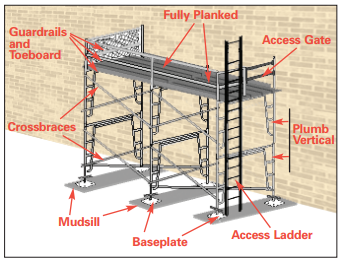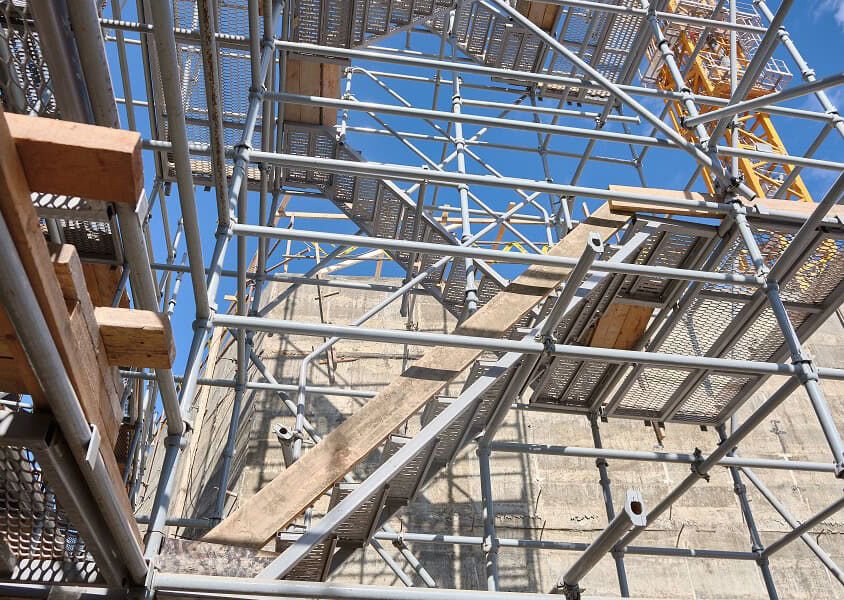Professional Scaffolder Surrey: Your Trusted Partner for Safe Installations
Professional Scaffolder Surrey: Your Trusted Partner for Safe Installations
Blog Article
Checking Out the Numerous Kinds Of Scaffolding Used in Building Jobs
The building industry depends greatly on various types of scaffolding to meet details job needs, each offering distinctive advantages and applications. Typical frame scaffolding provides a strong structure for general tasks, while put on hold scaffolding is essential for job on high-rise frameworks.

Conventional Structure Scaffolding
Traditional framework scaffolding is just one of one of the most extensively made use of methods in the construction market due to its effectiveness and flexibility. This system contains horizontal and vertical frameworks that are assembled to create a stable system for employees and products. The major components include upright messages, horizontal ledgers, and angled dental braces, which together give a solid structure that can sustain substantial tons.
One of the crucial benefits of typical frame scaffolding is its adaptability to numerous building and construction tasks, varying from household structures to big commercial frameworks. The modular style permits easy assembly and disassembly, making it effective for both short-term and long-term projects. Furthermore, the system can be customized in elevation and size, fitting different structure designs and site problems.
Security is vital in scaffolding applications, and standard frame systems are equipped with guardrails and toe boards to stop falls and make sure employee protection. Normal assessments and adherence to safety guidelines are crucial in preserving the honesty of the scaffold (Scaffolding). Overall, traditional structure scaffolding continues to be an essential selection in the building and construction market, giving a reliable platform for labor and enhancing total job effectiveness

Suspended Scaffolding
Suspended scaffolding uses an unique solution for building and construction tasks that require access to raised surface areas, especially in circumstances where traditional framework scaffolding might be not practical. This sort of scaffolding is normally suspended from the roofing system or top levels of a framework, using a system of platforms, sheaves, and ropes to develop a working space that can be adapted to different elevations.
Among the key advantages of put on hold scaffolding is its versatility. It can be quickly repositioned or lowered to accommodate changes in building demands, making it excellent for tasks such as window installment, façade work, and maintenance on skyscrapers. Furthermore, the very little footprint of suspended scaffolding permits for far better use of ground room in urban atmospheres, where room is often limited.
Safety and security is a vital factor to consider in the usage of put on hold scaffolding. Proper rigging and securing systems have to be employed to make sure stability and avoid mishaps. Operators needs to likewise be educated in the safe use this devices. Overall, suspended scaffolding supplies a efficient and efficient service for accessing hard-to-reach areas in different building circumstances, boosting both productivity and security on site.
System Scaffolding
System scaffolding, usually considered a modern remedy in the scaffolding industry, includes pre-engineered parts that can be swiftly assembled and adjusted for numerous building tasks. Scaffolding. This sort of scaffolding is defined by its modular style, which permits for convenience and performance on task sites, suiting different elevations and structural needs
Typically made from high-strength steel or aluminum, system scaffolding provides enhanced durability and security. The components include upright posts, horizontal ledgers, and diagonal dental braces, which adjoin safely, ensuring a robust framework. The layout usually incorporates standardized installations, simplifying assembly and disassembly procedures, consequently decreasing labor time and costs.

Rolling Scaffolding
Rolling scaffolding is a versatile option to traditional set scaffolding, made for mobility and ease of use on building and construction sites. This kind of scaffolding consists of a system sustained by structures with wheels, enabling workers to conveniently move it as needed. The movement attribute significantly boosts performance, as it decreases downtime connected with setting up and disassembling taken care of scaffolding.
Commonly created from light-weight materials such as aluminum or steel, rolling scaffolding uses a strong yet portable my blog option for tasks requiring constant repositioning - Scaffolding. It is especially helpful in jobs such as paint, drywall setup, and electric job, where access to different elevations and locations is essential
Safety and security is vital in rolling scaffolding layout, with features such as securing wheels to avoid unexpected activity when being used, and guardrails to secure workers from falls. Furthermore, lots of models are adjustable in height, suiting different task needs.
Cantilever Scaffolding

The layout of cantilever scaffolding generally includes utilizing brackets or arms anchored to a building or structure, enabling the system to prolong external securely. Security is critical; hence, these scaffolds need to be engineered to stand up to various loads and ecological conditions. Normal inspection and upkeep are necessary to make sure structural integrity and employee safety.
Cantilever scaffolding is preferred for its adaptability and efficient use of area, making it a popular choice in city settings where room constraints prevail. It promotes much easier access to high elevations, inevitably contributing to the total performance of construction tasks. Similar to all scaffolding types, correct training and adherence to safety and security criteria are critical for employees utilizing cantilever scaffolding.
Final Thought
In verdict, the varied sorts of scaffolding used in building and construction jobs each offer distinctive objectives customized to particular website needs. Traditional frame scaffolding provides stability, while put on hold scaffolding supplies convenience for elevated jobs. System scaffolding promotes fast setting up, and rolling scaffolding boosts mobility for varying workplace. Cantilever scaffolding properly addresses barriers in city setups. Comprehending these scaffolding types is vital for maximizing security and efficiency in building and construction, ultimately contributing to the effective conclusion of projects.
Conventional frame scaffolding provides a strong structure for general tasks, while put on hold scaffolding is crucial for work on skyscraper structures.Rolling scaffolding is a versatile option to conventional fixed scaffolding, created for flexibility and ease of usage on construction sites. As with all scaffolding you can find out more types, proper training and adherence read here to safety and security criteria are essential for employees using cantilever scaffolding.
Typical frame scaffolding supplies stability, while suspended scaffolding offers versatility for elevated jobs. System scaffolding assists in quick assembly, and rolling scaffolding enhances wheelchair for varying job atmospheres.
Report this page